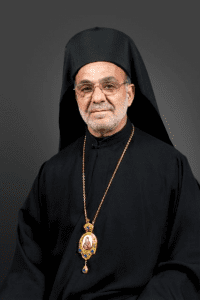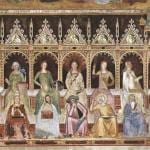I greet you with special joy on this feast – the advent of our salvation, our freedom from imprisonment (Psalm 141), and the dawning of the Good News.
The thrice-holy God has provided us this radiant feast in the midst of the Great Fast. It is a foretaste and promise of what awaits us if we are faithful in that fast. All too often we regard this feast as a temporary break from the Great Fast when our ascetic discipline is relaxed for a day. Yet, this feast does not stand alone for it is inextricably linked to the Entrance of the Most Holy Theotokos into the Temple. In the Feast of the Entrance the Theotokos, as a child, assumes the God pleasing asceticism of prayer, fasting, and good works. Through this asceticism, she is prepared when the angel visits her. It is precisely because of her life of asceticism in the Temple that she is able to say, “Be it done unto me according to thy word.” (Luke 1:38)
In her fiat, the Most Holy Theotokos unties the first knot woven by the demons after the Fall of Adam and Eve. She is able to utter those salvific words, “Be it done unto me according to thy word,” because those ascetical practices to which she dedicated herself in the Temple purified her nous which had been clouded by the disobedience of our first parents. In the darkness of the passions, the nous is confused and weakened to such a state that it is powerless to fight the unclean spirits. However, through her asceticism, her nous was purified and illumined to the extent that she was able to recognize the messenger and his message from the triune God.
According to Metropolitan Hierotheos Vlachos, “She had used a special method for knowing God and communing with Him, as Saint Gregory Palamas interprets in a wonderful and inspired way: it is hesychia, the hesychastic way. The Panagia understood that one can reach not by logic, sensation, imagination, and human fame, but through one’s ‘nous’, which is sometimes called the eye of the heart.” (The Twelve Feasts of the Lord, p.25)
This is vitally important for contemporary seekers of God who are told that there are many paths that lead to God. Yet, Holy Scripture and the testimony of the holy fathers tell us that there is only one way – the road taken by the Most Holy Theotokos. It is not coincidence that the one who ushers in our salvation lived the life of a hesychast.
A contemporary father of the Church, Saint Justin Popovic echoes these sentiments when he writes, “The cleansing of the intellect is not a dialectical, discursive and theoretical activity, but an act of grace through experience and is ethical in every respect. The intellect is purified by fasting, vigils, silence, prayer, and other ascetic practices.” (Orthodox Faith and Life in Christ, p.136)
The Most Holy Theotokos sought silence and non-acquisitiveness because she desired union with God, deification. Today’s feast and her example of the ascetical life in the Temple point us in the direction toward God.
The world around us swirls in a constant state of distraction and cacophony. The example of this most holy feast shows us a path of peace and tranquility. May we be blessed to follow that path, most especially during this Great Fast appointed for our repentance and salvation.
 You can find other thoughts from Bishop Thomas here, here, here, here and especially this one of the work of ministering to differently abled folk in the church.
You can find other thoughts from Bishop Thomas here, here, here, here and especially this one of the work of ministering to differently abled folk in the church.












